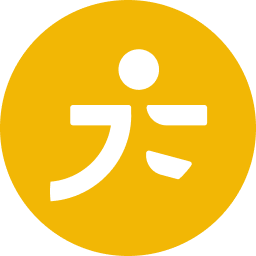In today’s modern world, it’s easier than ever to find yourself slouched over a phone or slumped over a laptop for hours at a time. Being locked on a screen for long periods of time, especially when you’re not positioned correctly, can take its toll on your muscles, joints, and ligaments.
When your body gets used to being hunched over for hours, it can be easy to continue that same posture, even when you’re not in front of a screen.
If you want to kick your slouching habit, there are simple exercises and strategies that can help. In this article, we’ll look at 8 steps you can take to reduce slouching and improve your overall posture.
What are the benefits of better posture?
Posture is the way your body is positioned when you’re standing, sitting, or lying down. Correct posture puts the least amount of strain on your muscles and joints.
Slouching, slumping, and other types of poor posture can cause muscle tension, as well as back pain, joint pain, and reduced circulation. Poor posture can even lead to breathing issues and fatigue.
The benefits of good posture include:
- Improved balance. Having better balance not only lowers your risk of falls, it can also improve your athletic ability.
- Less back pain. Good posture puts less stress and tension on the disks and vertebra in your spine.
- Lower risk of injury. Moving, standing, and sitting correctly reduces the strain on your muscles, joints, and ligaments.
- Less fatigue. When your muscles are used more efficiently, it can help conserve your energy.
- Fewer headaches. Poor posture can put extra strain on your neck, which can lead to tension headaches.
- Improved breathing. Good posture allows your lungs to expand more fully, allowing you to breathe easier.
- Better circulation. When your vital organs aren’t compressed by slouching, it can help your blood to flow more easily through your blood vessels and organs.
The first step to not slouching is to be aware of your posture. We often get so caught up in what we’re doing that we forget to check our posture.
Make it a habit to check on your posture throughout the day. Notice how you’re standing, sitting, or walking. Make corrections whenever you find yourself slouching or hunching your back or shoulders, or pushing your head or neck forward to look at a screen.
The following strategies and exercises can help you cut back on slouching and use good posture instead.
1. Stand tall
You might not pay much attention to how you stand, but it can make a big difference to your posture. To stand with good posture, keep these tips in mind:
- Stand straight and tall with your shoulders relaxed and pulled back slightly. Think of an invisible piece of string gently pulling your head toward the ceiling.
- Stand with your feet approximately shoulder-width apart, with your weight mostly on the balls of your feet.
- Keep your knees bent slightly.
- Tuck in your stomach.
- Keep your head level, not bent forward, with your ears over your shoulders.
- Shift your weight from your toes to your heels, or from one foot to the other if you have to stand in one place for a long time.
2. Sit correctly
When seated, keep these tips in mind to ensure you’re using good posture:
- Sit up straight with your shoulders relaxed, but not hunched or rounded.
- Choose a chair height that allows you to keep your feet firmly planted on the floor. Avoid crossing your legs.
- Keep your knees level or slightly higher than your hips.
- Sit back in your chair so the chair back supports your spine.
- Pay attention to your head position. Don’t let your head and chin sit forward of your shoulders.
- Keep your ears aligned over your shoulders.
- Keep your computer screen at eye level to prevent your neck from bending forward or backward.
3. Move around
Holding one position, whether sitting or standing, for a long time can cause muscle tension, discomfort, and fatigue. The effects may be even more severe if you’re in a slouched position.
To prevent muscle pain and fatigue, make a point to get up, stretch, and walk around for at least a few minutes every hour. Set an alarm on your phone to remind you to get up and move.
It may also help if you can do a different task that requires you to use different muscles to the ones you’re using while seated or standing.
4. Wall slide

If you’ve been sitting in one position for a while, the wall slide is a good way to reset your body and to remind you of what good upright posture feels like. It may also be helpful for relieving tightness in your neck and shoulders.
To do a wall slide:
- Stand with your back, butt, shoulders, and head pressed firmly against a wall. Your feet can be a foot or two away from the wall to help you position your body correctly.
- Keep a tilt in your pelvis so there’s no arch in your back. Keep your knees slightly bent.
- Extend your arms straight above you with the backs of your hands against the wall. This is your starting position. You may find it difficult to raise your arms all the way up at first, and that’s OK. Lift them as far as you can while keeping your body pressed against the wall.
- With your back tall and your chest open, squeeze the muscles of your mid-back as you slide your arms down toward your shoulders. Keep the backs of your hands, elbows, shoulders, spine, butt, and head pressed up against the wall throughout the movement.
- Slide your arms downward until they’re slightly lower than shoulder height.
- Hold this position for a moment, then push your arms back up to the starting position without anything lifting from the wall.
- Repeat 10–12 times.
5. Child’s pose
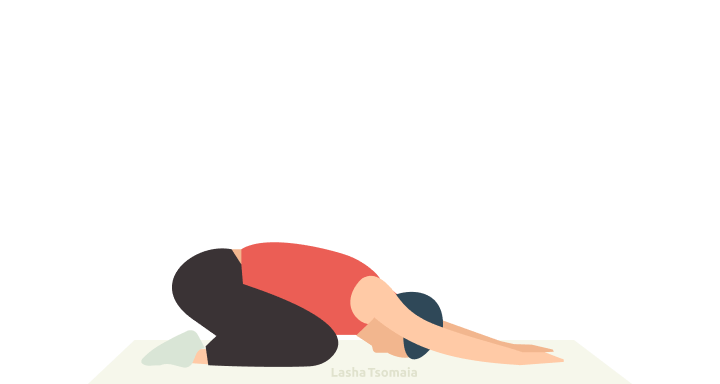
This simple exercise helps to stretch your spine, as well as your glutes and hamstrings. It can also help ease tension in your back and neck.
To do this pose:
- Start on all fours with your hands and knees on the floor.
- Sink your hips back down toward your feet, while walking your hands out in front of you. If your thighs won’t go all the way down, you can place a pillow under them for support.
- Gently place your forehead on the floor while keeping your arms extended out in front of you.
- Relax and breathe deeply.
- Hold this pose for 5 minutes, remembering to breathe deeply the entire time.
6. Shoulder blade squeeze
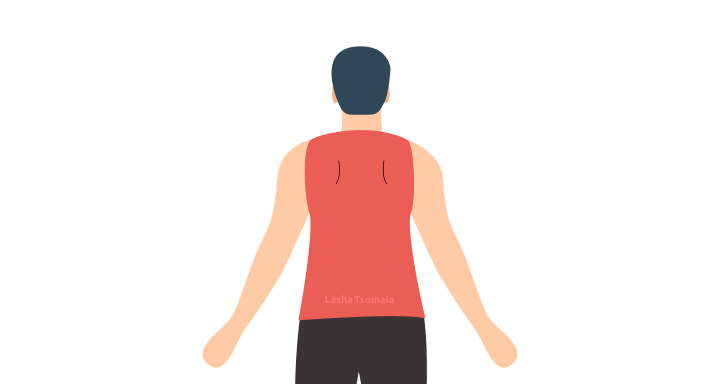
This exercise can help improve your posture by stabilizing your shoulder and upper back muscles. It can also help make your chest muscles more flexible.
To do this exercise:
- Stand tall with your arms at your side.
- Pull your shoulders back and downward slightly, as though you’re trying to get your shoulder blades to touch. Don’t overextend, but pull until you feel a slight stretch in your muscles.
- Hold for a few seconds and return to the starting position.
- Repeat 10 times.
7. Plank
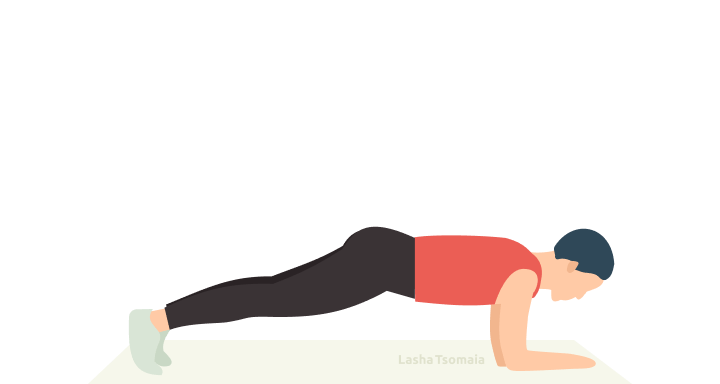
Strong core muscles play an important role in helping you maintain good posture. That’s why building strength in your core is key if you want to avoid slipping into bad posture habits.
Your core muscles include your abdominal muscles and the muscles around your pelvis and lower back.
One of the best exercises for building a strong core is the plank. This exercise can also help relieve pain and stiffness from sitting or standing incorrectly.
To do this move:
- Start on all fours, with your hands directly below your shoulders and your knees below your hips.
- Lower yourself onto your elbows and straighten your legs behind you, keeping your feet hip-width apart.
- Keep your core tightened and your back straight.
- Hold for 20–30 seconds. Once you get used to this pose, you can hold it for longer.
8. Bridge
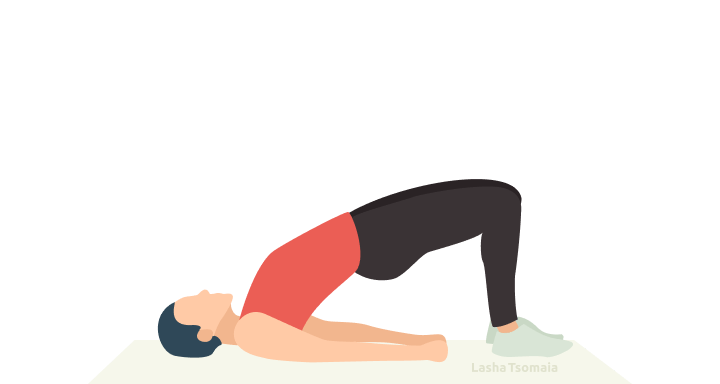
The bridge is another great core-strengthening exercise.
To do this exercise:
- Lie on your back with your knees bent, feet flat on the floor, and arms slightly out to the side, palms on the floor.
- Tightening your core muscles and glutes, raise your hips off the floor so your knees are in line with your shoulders.
- Hold for 30 seconds, then lower your hips.
- Repeat 5 to 8 more times.
The bottom line
One of the keys to not slouching or hunching is to constantly be mindful of your posture.
Set alerts on your phone to remind yourself to sit up straight and to take regular breaks so your muscles don’t get stiff or tense from being in one position for too long.
Along with posture checks and movement, it also helps to do regular stretches and exercises to keep your muscles strong, flexible, and better able to help you maintain good posture.
